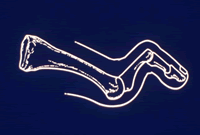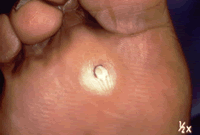Common Foot and Ankle Disorders
Hammertoes
Description
 Hammertoes are a contracture of the toes as a result of a muscle imbalance - a condition where the stronger muscles in the leg that pull the toes down overpower the weaker muscles that are inside the foot that keep the toe straight. Hammertoes can be flexible or rigid in nature and involve the bigger of the toe joints within toes 2 through 5. (A contracture of the joint at the tips of toes 2 through 5 is called a Mallet Toe. When both joints are contracted, it is called a Claw Toe. A contracture of the joint in the Bit Toe itself is called a Hallux Hammer toe.) When hammer toes are rigid, it is not possible to straighten the toe out by manipulating it. Frequently, hammertoes develop corns on the top of the toe as a result of rubbing on the inside of the shoe.
Hammertoes are a contracture of the toes as a result of a muscle imbalance - a condition where the stronger muscles in the leg that pull the toes down overpower the weaker muscles that are inside the foot that keep the toe straight. Hammertoes can be flexible or rigid in nature and involve the bigger of the toe joints within toes 2 through 5. (A contracture of the joint at the tips of toes 2 through 5 is called a Mallet Toe. When both joints are contracted, it is called a Claw Toe. A contracture of the joint in the Bit Toe itself is called a Hallux Hammer toe.) When hammer toes are rigid, it is not possible to straighten the toe out by manipulating it. Frequently, hammertoes develop corns on the top of the toe as a result of rubbing on the inside of the shoe.
 They may also cause a bothersome callous on the ball of the foot. This occurs as a result of the toe pressing downward on the bone behind the toe, which is caused by the beginning of a dislocation of that joint at the base of the toe(s). This condition is a warning of impending dislocation of a joint. At this juncture, surgery may be the best option. It should be noted that injections with cortisone are never an option for any of the symptoms associated with hammertoes.
They may also cause a bothersome callous on the ball of the foot. This occurs as a result of the toe pressing downward on the bone behind the toe, which is caused by the beginning of a dislocation of that joint at the base of the toe(s). This condition is a warning of impending dislocation of a joint. At this juncture, surgery may be the best option. It should be noted that injections with cortisone are never an option for any of the symptoms associated with hammertoes.
Diagnosis
Each patient's foot is unique. Diagnosis of the cause is just as important as tailoring the most appropriate treatment. A physical examination will include observing the patient standing and walking, and must be accompanied by weight bearing x-rays.
Treatment
Symptomatic treatment of hammertoes consists of such things as open toed or extra depth shoes. "If the shoe fits, wear it."
Curative treatment of hammertoes varies depending upon the severity of the deformity. The surgical procedure(s) are tailored to fit the exact nature of the condition. At the very least, a small section of bone is removed at the level of the rigid joint. If it is a Hallux (big toe) hammer toe or a hammer toe of toes 2 or 3, the entire joint must be removed and fused with a wire (that comes out after 6 weeks) so that it remains straight at all times. In toes 4 and 5, only one part of the joint is removed.
Hammertoe surgery as with any surgery involving bones, must be performed in a hospital or surgical center setting. After care can be as simple as walking in a special post operative shoe for two to six weeks, or in more severe cases up to six weeks of non-weight bearing and the use of crutches. Again, each person's foot is different. The surgeon will know what to do after a thorough examination together with weight bearing x-rays.
